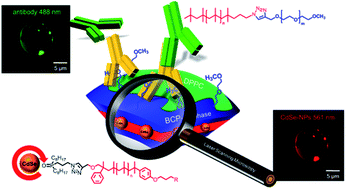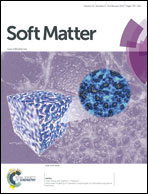Lateral surface engineering of hybrid lipid–BCP vesicles and selective nanoparticle embedding†
Abstract
Bio-inspired recognition between macromolecules and antibodies can be used to reveal the location of amphiphilic block copolymers (BCPs) in model biomembranes and their subsequent scaffolding with nanoparticles (NPs). Potential applications of this novel class of lipid–BCP membranes require an understanding of their compositional heterogeneities with a variety of different molecules including natural proteins or synthetic NPs, whose selective incorporation into a specific part of phase separated membranes can serve as a model system for the targeted delivery of therapeutics. We demonstrate the selective incorporation of polymer-functionalized CdSe NPs into the polymer-rich domains in vesicular hybrid membranes using 1,2-dipalmitoyl-sn-glycero-3-phosphocholine (DPPC, Tm = 41 °C) or 1,2-dioleoyl-sn-glycero-3-phosphocholine (DOPC, Tm = −20 °C) as the lipid component. Furthermore, we demonstrate a method to detect PIB–PEO based amphiphilic BCPs on liposomal surfaces by a PEO binding antibody (anti-PEO). As a result, hybrid membrane morphologies, which depend on the lipid/BCP composition, are selectively monitored and engineered.


 Please wait while we load your content...
Please wait while we load your content...